Physical Address
304 North Cardinal St.
Dorchester Center, MA 02124
The diagnosis of benign and malignant diseases of the pancreas and biliary tree historically have relied on a detailed history and complete physical examination, with correlation of the results of clinical chemistries. Imaging of the hepatic and pancreatic parenchyma and ductal anatomy has, however, evolved as critical for accurate diagnosis and for guiding therapy. Ultrasonography (US), computed tomography (CT), and magnetic resonance imaging (MRI) have become important noninvasive modalities in the routine investigation of pathologic conditions of the biliary tree or pancreas (see Chapters 12 and 13 ).
Invasive procedures for imaging the biliary and pancreatic ductal systems, primarily percutaneous cholangiography (PTC) (see Chapter 20 ) or endoscopic retrograde cholangiopancreatography (ERCP) (see Chapter 31 ) remain important therapeutically, but diagnostically, these have been almost entirely replaced by less invasive modalities. Endoscopic ultrasonography (EUS) has become an essential tool for the diagnosis and treatment of pancreatic and biliary pathology. Its high-resolution images complement the more general findings of cross-sectional imaging and result in a higher sensitivity for diagnosis of early-stage disease and detection of smaller lesions. Linear array echoendoscopes permit guided passage of needles and devices through the endoscope, allowing biopsies to be obtained and permitting therapeutic interventions. This chapter discusses the techniques of endosonography in the diagnosis, staging, and treatment of benign and malignant disease of the pancreas and biliary tree.
The pancreas is located posterior to the stomach and is readily seen by EUS imaging through the wall of the stomach and duodenum. With the transducer in the duodenum, the pancreatic head and uncinate process, ampulla of Vater, pancreatic ducts, common bile duct (CBD), and the surrounding vascular and nodal structures can be visualized. With the transducer in the stomach, the pancreatic body and tail, gallbladder, and left lobe of the liver are seen. Additionally, the celiac, splenic, hepatic, and superior mesenteric arteries, as well as the splenic, superior mesenteric, and portal veins are all seen in detail (see Chapter 2 ).
The normal pancreatic parenchyma has a homogeneous echogenic appearance ( Fig. 22.1 ), and tumors usually appear hypoechoic, often with irregular borders, in sharp distinction from healthy tissue ( Fig. 22.2 ). Small tumors of the pancreas that are often missed by CT or MRI are readily imaged by EUS. For example, islet cell tumors, which are often encapsulated and small, are more readily detected on EUS than cross-sectional imaging and appear as well-demarcated hypoechoic lesions (see Chapter 65 ). Other neuroendocrine tumors, such as gastrinomas, may be isoechoic within the pancreatic parenchyma and difficult to identify without careful, tedious, real-time imaging ( Fig. 22.3 ). Ampullary tumors are also often seen and staged on EUS because of their proximity to the duodenal wall, CBD, and pancreatic duct ( Fig. 22.4 ) (see Chapter 59 ). Extrahepatic bile duct tumors can also be detected and described in detail with EUS imaging ( Fig. 22.5 ).
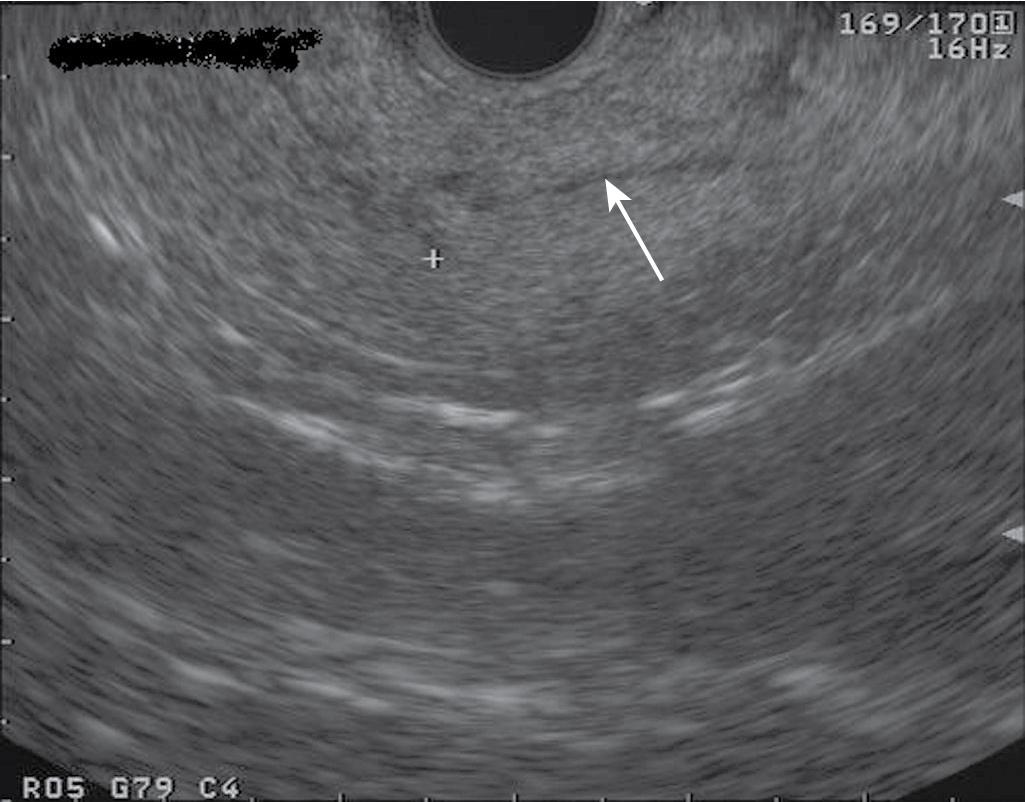
![FIGURE 22.2, Solid, irregular, hypoechoic mass (M) in the pancreatic head seen with abrupt termination of a dilated common bile duct (CBD) and contact with the portal confluence (portal vein [PV] and superior mesenteric vein [SMV] ). Cytology obtained by endoscopic ultrasound–guided fine-needle aspiration proved to be adenocarcinoma. FIGURE 22.2, Solid, irregular, hypoechoic mass (M) in the pancreatic head seen with abrupt termination of a dilated common bile duct (CBD) and contact with the portal confluence (portal vein [PV] and superior mesenteric vein [SMV] ). Cytology obtained by endoscopic ultrasound–guided fine-needle aspiration proved to be adenocarcinoma.](https://storage.googleapis.com/dl.dentistrykey.com/clinical/Endoscopicultrasoundofthebiliarytractandpancreas/1_3s20B9780323697842000359.jpg)
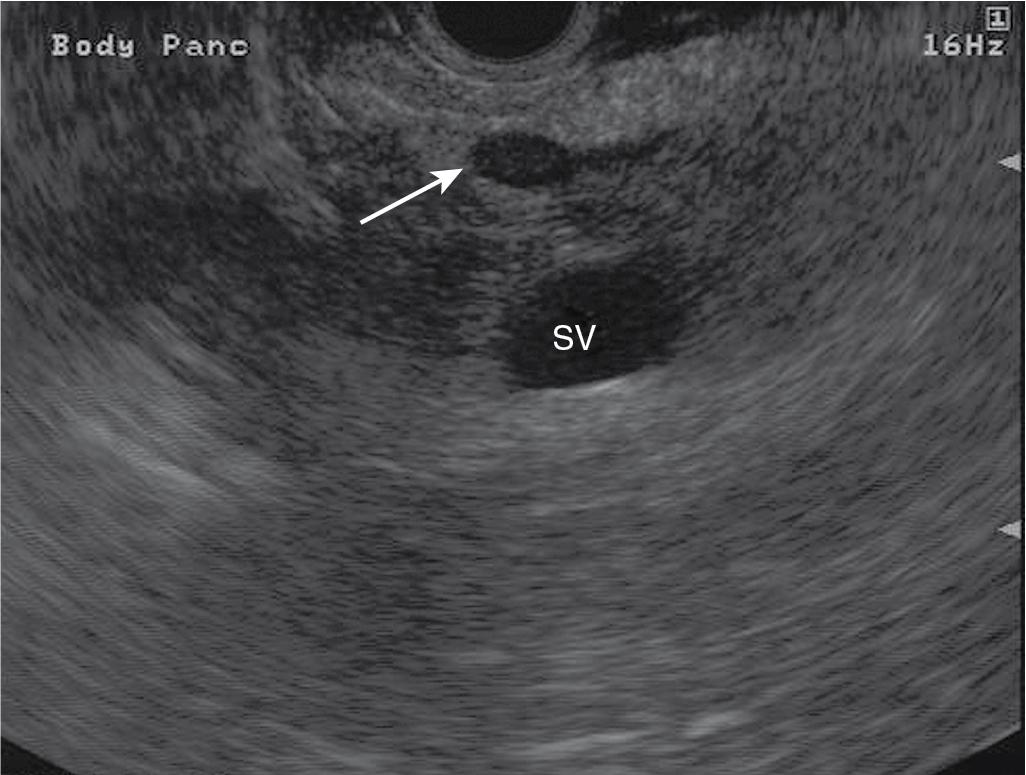
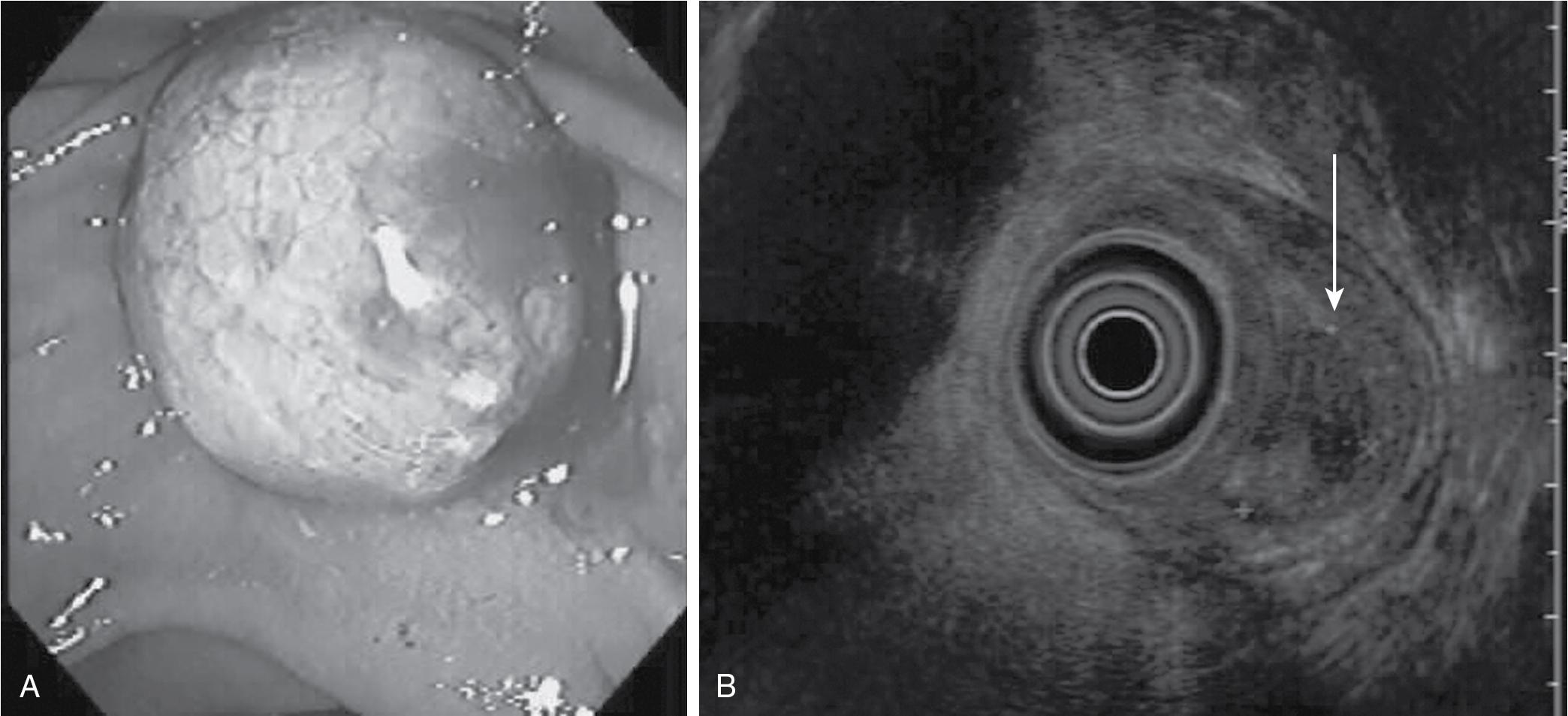
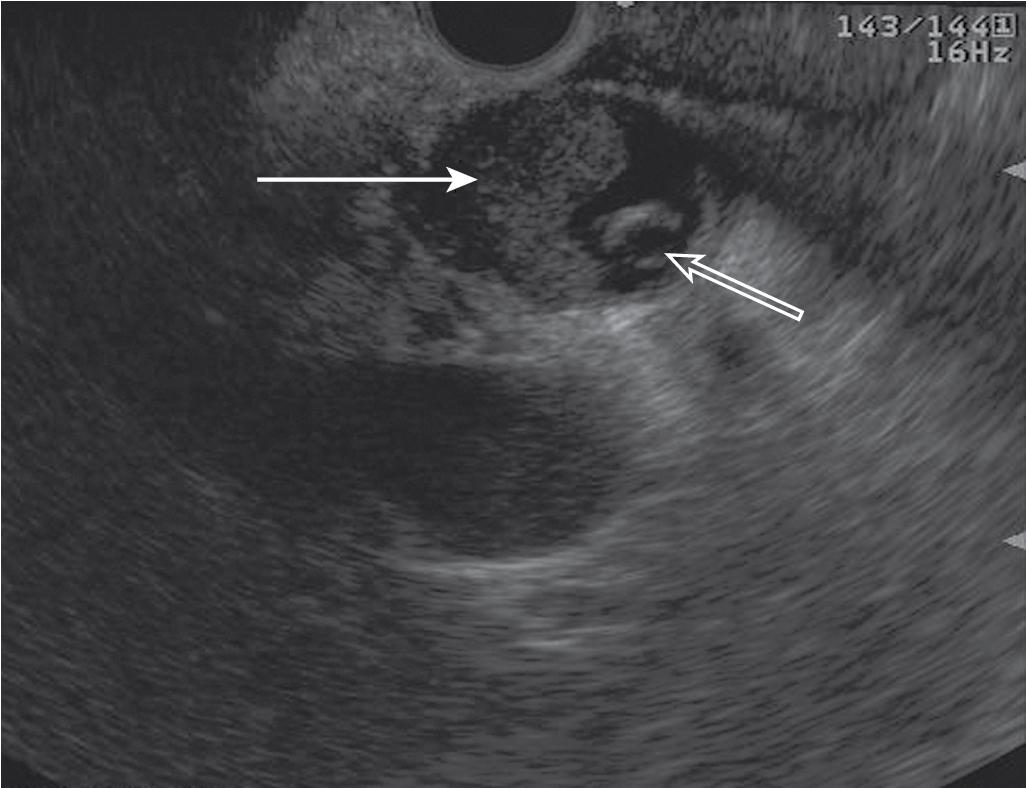
Cysts of the pancreas are generally anechoic and well demarcated and thus easily identified even when small (see Chapter 60 ). Some cysts may have internal echoes or solid nodules, which raise concern for a mucinous lesion or associated tumor ( Figs. 22.6 and 22.7 ). Cysts can easily be distinguished from vascular structures using Doppler flow. Serous cystadenomas may also appear isoechoic with the pancreas and require careful imaging for proper identification ( Fig. 22.8 ).
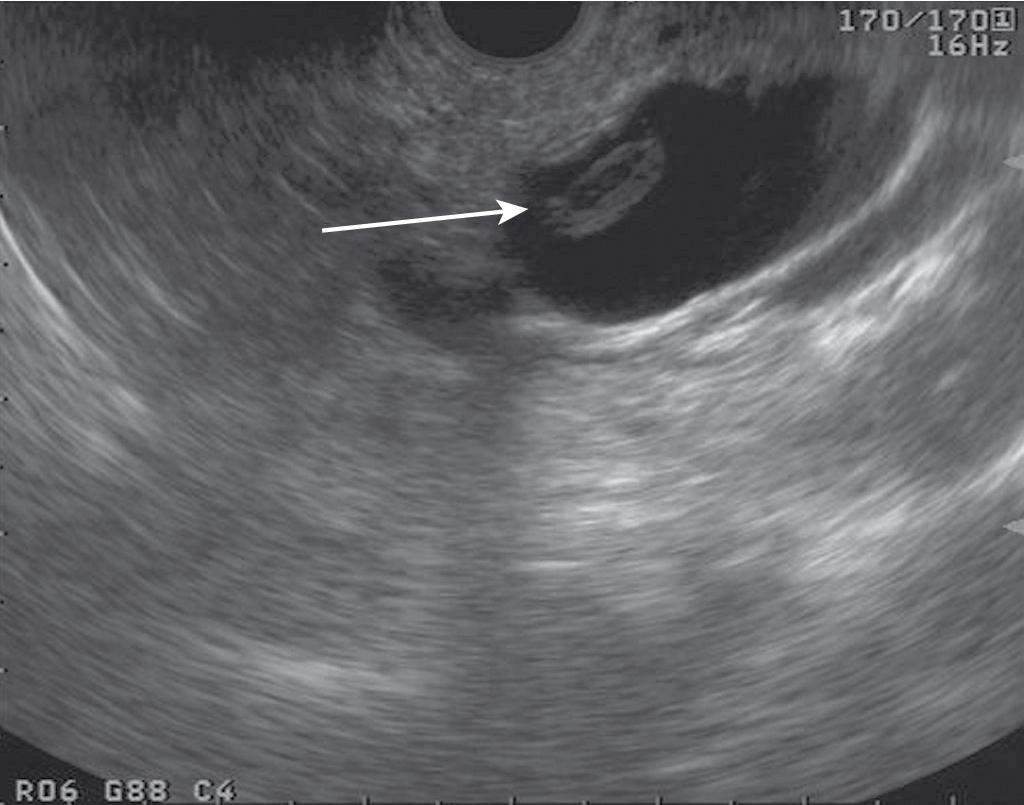
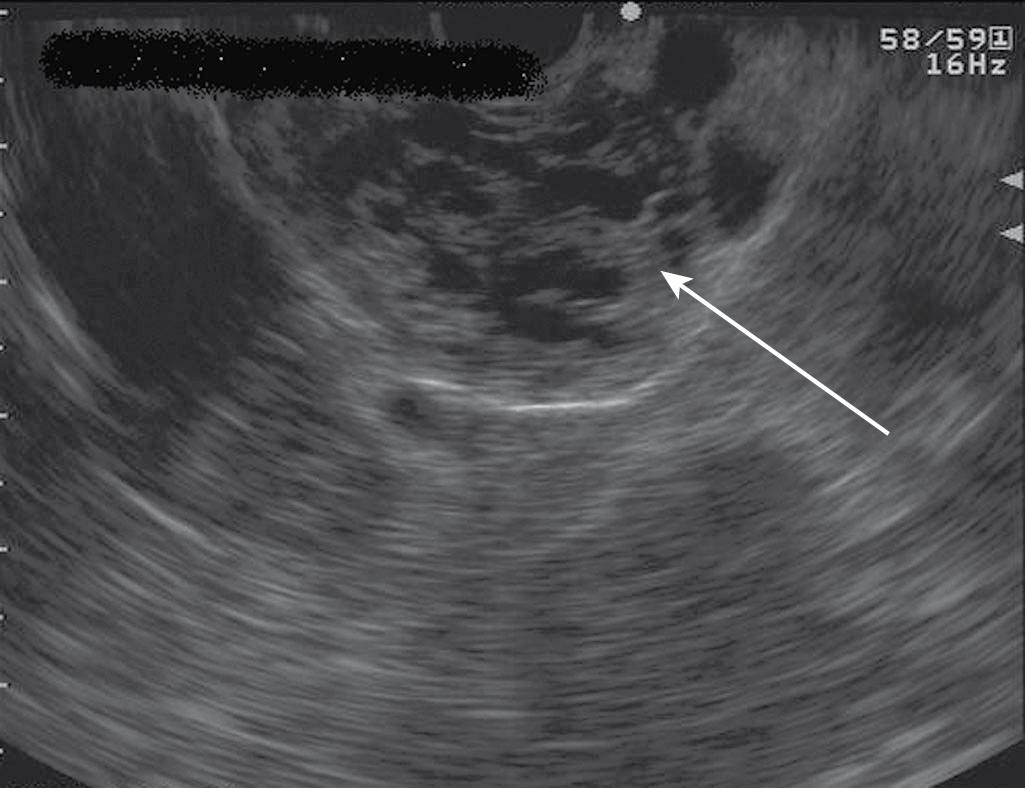
The development of linear array echoendoscopes, which scan an area orthogonally in line with the endoscope (thus in line with the biopsy channel), has allowed the development of EUS-guided fine-needle aspiration (EUS-FNA) and fine-needle biopsy (EUS-FNB). The indications for EUS-guided aspiration or biopsy include pathologic confirmation of a suspected pancreatic or periampullary cancer, evaluation of pancreatic masses, bile duct lesions or abnormal lymph nodes, and aspiration of pancreatic cysts. EUS-guided needle puncture has also provided the platform for therapeutic EUS-guided techniques (see Chapter 30 ) .
Within the duodenum or stomach, the EUS probe is positioned near the target lesion, typically less than 3 cm away. The area is then interrogated with Doppler flow to ensure the absence of significant vascular structures in the needle path. A 25-gauge, 22-gauge, or 19-gauge needle can then be directed into the target lesion. The tip and shaft of the needles used for FNA produce a bright, hyperechoic image. This allows the needle to be followed in real time to ensure precise positioning within the target lesion ( Fig. 22.9 ). Ideally, a cytopathologist or cytotechnologist should be present at the time of the FNA to determine the cellular adequacy of the specimen, improve diagnostic yield, and reduce the need for additional pass of the biopsy needle. (Khoury et al, 2019). Alternatively, multiple punctures (six to seven) should be performed to ensure an adequate cytologic specimen. Cyst fluid can also be aspirated and sent for cytology, tumor markers, and chemical analysis ( Fig. 22.10 ). More recently, the development of needles that can obtain core samples (FNB) allows tissue with preserved architecture to be acquired, as opposed to purely cytologic specimens. Several maneuvers have been described to improve diagnostic yield, including the use of a “fanning” technique, whereby multiple areas are sampled within a lesion, particularly the peripheral area of lesion to improve yield and reduce the number of passes required for diagnosis. The use of suction for FNA of lymph nodes or solid masses has been suggested to have improved cellularity; however, it may yield more bloody samples. , The reinsertion of a stylet within the fine needle does not appear to increase yield, may increase the bloodiness of the sample, and can increase procedural time. However, the use of a stylet slow-pull technique may confer some advantage for diagnostic yield.
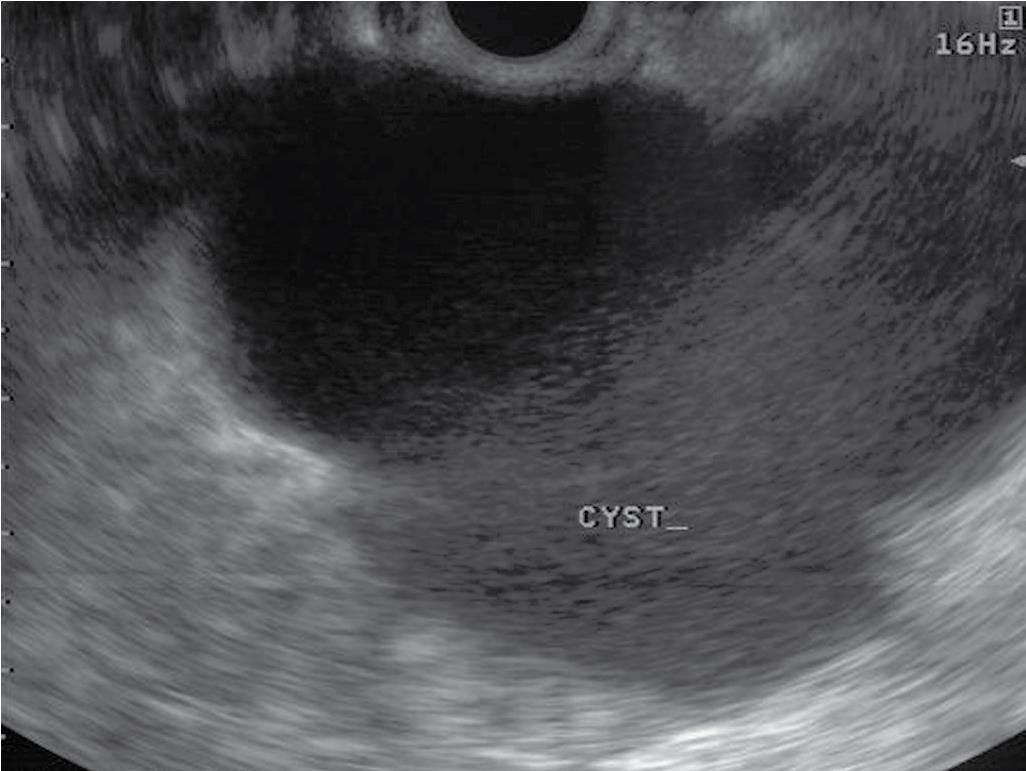
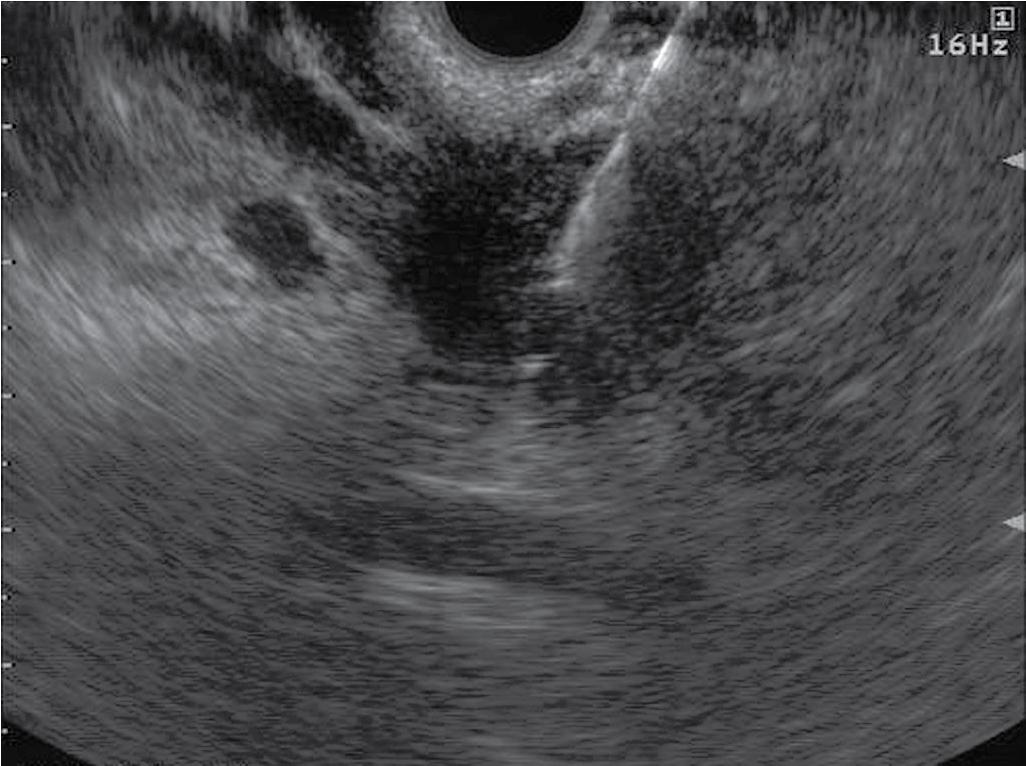
Solid masses of the pancreas may represent a primary pancreatic cancer (see Chapter 62 ), neuroendocrine tumor (see Chapter 65 ), metastatic lesion (see Chapter 64 ), or focal pancreatitis (see Chapter 55 ). These masses may be difficult to visualize on noninvasive imaging when small. EUS allows high-resolution imaging of the pancreas as well as facilitating guidance of FNA and FNB.
Some solid lesions in the pancreas may not need preoperative biopsy if the result of biopsy would not change the decision to resect the lesion. Current surgical guidelines recommend proceeding to surgery for resectable pancreatic lesions for which surgery is indicated without first obtaining a diagnostic biopsy. However, patients with locally advanced pancreatic lesions require histologic diagnosis before initiating chemotherapy or radiation. Biopsy is also indicated before surgical resection for those patients in whom there is suspicion for autoimmune pancreatitis (see Chapter 54 ).
EUS-FNA has been shown to have superior diagnostic accuracy for pancreatic malignancy than percutaneous CT-guided and US-guided approaches, especially for small lesions. EUS-FNB has a diagnostic accuracy similar to EUS-FNA; therefore either EUS-FNA or FNB is the preferred modality for diagnostic sampling of pancreatic lesions.
Recent randomized controlled trials assessing EUS-FNA and FNB tissue acquisition reported diagnostic accuracies of 81% to 100% and 85% to 94% for FNA and FNB, respectively. , In these studies, there was an equivalent complication rate of between 0% and 3% for both FNA and FNB, with bleeding, abdominal pain, and pancreatitis the most common complications cited.
There is some suggestion that FNB produces a superior specimen with preserved tissue architecture over FNA samples. A retrospective study looking at EUS sampling of pancreatic lesions using a 22-gauge FNA needle and 25-gauge FNB needle in 76 patients found no difference in safety or technical success; however, the 25-gauge FNB needle produced a higher amount of diagnostic material and superior preservation of tissue architecture despite the smaller caliber needle. Additionally, a large retrospective study found that EUS-FNB was superior to EUS-FNA in obtaining tissue for genomic testing compared with FNA samples (90.9% vs. 66.6%, respectively). More research is needed in this area, as molecular testing is becoming more common and more directed therapies are becoming available.
Become a Clinical Tree membership for Full access and enjoy Unlimited articles
If you are a member. Log in here